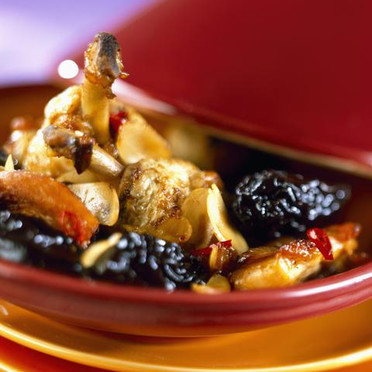
Moroccan Tajine
Tajines in Moroccan cuisine are slow-cooked stews braised at low temperatures, resulting in tender meat with aromatic vegetables and sauce. They are traditionally cooked in the tajine pot, whose cover has a knob-like formation at its top to facilitate removal. While simmering, the cover can be lifted off without the aid of a mitten, enabling the cook to inspect the main ingredients, add vegetables, move things around, or add additional braising liquid. To learn how to make a Moroccan tajine first hand, consider taking A Taste of Morocco tour or a local cooking class from a chef at a cooking school or university closest to where you live.
Tajine or tagine is a type of dish found in the North African cuisines of Morocco, which is named after the special pot in which it is cooked. The traditional tajine pot is formed entirely of a heavy clay which is sometimes painted or glazed. It consists of two parts; a base unit which is flat and circular with low sides, and a large cone or dome-shaped cover that rests inside the base during cooking. The cover is designed to promote the return of all condensation to the bottom. With the cover removed, the base can be taken to the table for serving. The clay used to make a tajine comes from various regions in Morocco. Morocco’s Sahara Desert has orange colored clay as does the Ouarzazate region. Some of the best cooking tajines can be found in the Tizin’ Tichka pass and tajines for decorative purposed in the pottery capital, Safi.
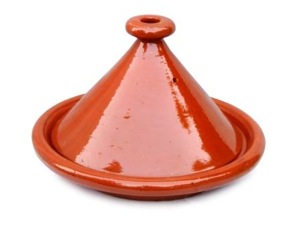
Traditional Clay Tajine
Most tagines involve slow simmering of less-expensive meats. For example, the ideal cuts of lamb are the neck, shoulder or shank cooked until it is falling off the bone. Very few Moroccan tajines require initial browning; if there is to be browning it is invariably done after the lamb has been simmered and the flesh has become butter-tender and very moist. In order to accomplish this, the cooking liquid must contain some fat, which may be skimmed off later.
Moroccan tajines often combine lamb or chicken with a medley of ingredients or seasonings: olives, quinces, apples, pears, apricots, raisins, prunes, dates, nuts, with fresh or preserved lemons, with or without honey, with or without a complexity of spices. Traditional spices that are used to flavour tajines include ground cinnamon, saffron, ginger, turmeric, cumin, paprika, pepper, as well as the famous spice blend Ras el hanout. Some famous tajine dishes are mqualli or emshmel (both are pairings of chicken, olives and citrus fruits, though preparation methods differ), kefta (meatballs in an egg and tomato sauce), and mrouzia (lamb, raisins and almonds).
Other ingredients for a tajine include any product that braises well: fish, quail, pigeon, beef, root vegetables, legumes, even amber and aga wood. Modern recipes in the West include pot roasts, ossobuco, lamb shanks and turkey legs. Seasonings can be traditional Moroccan spices, French, Italian or suited to the dish.
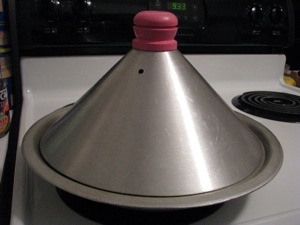
Aluminum Modern Tajine
Morocco, perhaps feeling pressure to catch up with Europe, is beginning to use the efficient pressure cooker to make tajines. Recently, European manufacturers have created tajines with heavy cast iron bottoms that can be fired on a stovetop at high heat. This permits browning meat and vegetables before cooking. While the similar Dutch oven and Sac spell (sach) (a cast iron pot with a tight cover) braises most efficiently in the oven, the tajine braises best on the stovetop.
Tajine makers, who want to remain loyal to the original cooking methods but save time, can still cook with saucepans and casseroles, but place them over gas versus a slow fire. Regardless of how you make tajine, you should make it with love and care as this will assure a delicious result. Also, keep in mind that it is difficult to make tajines for large groups because they don’t contain much more than sauce. As a result, a tajine is better prepared for your family or an intimate gathering of friends.
Tajines are a delicious meal if you enjoy exotic ingredients like lamb or chicken marinated in olive oil and garlic. (If you are vegetarian, you can request your tajine to be made without meat during your Moroccan travels). Meats are always first sautéed and then embellished with combinations of marinades including saffron, cumin, crushed red pepper, fresh coriander, parsley, chickpeas, and almonds. To be playful with the dishes, Moroccans sometimes add prunes, ginger, or hard boiled eggs. The standard dish will always include chicken, olives and salted lemons.
Some tricks to get your tajine like those of Moroccan mothers include using cooking butter (you can substitute for olive oil) and large quantities of chopped onions. Warm the onions until they reach their softest state; this will help the tajine sauce taste creamier. Adding a touch of honey is another secret.
Some differences in how tajines vary between regions include details of what spices, fats, and seasonal produce are used. Regardless of where your ingredients come from, one similarity throughout Morocco is that upon preparation, the tajine is commonly ate with couscous or thick wedges of freshly made hot bread used to scoop up the meat and vegetables.
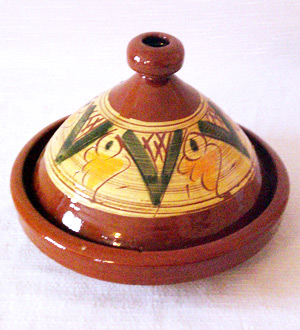
Decorative Moroccan Tajine
MOROCCAN TAJINE RECIPES: The following are a few of the most popular tajine recipes to recreate at home.
Recipe: Beef Tajine with Almonds and Prunes
Ingredients:
3 Lb. beef
4.oz butter
2 tablespoons of olive oil
2 large onions
1 teaspoon
salt
1/4 cup sugar
1/2 teaspoon ground black pepper
1 strip lemon peel
1 teaspoon powdered ginger
1 Ib dried prunes
1/2 teaspoon powdered saffron
blanched almonds
3 short cinnamon sticks
fresh water cress or mint
2 tablespoons of olive oil
Making a Beef Tajine with Almonds and Prunes:
Combine the oil and ground spices in a bow, then cut the beef into cubes, chop onions finely, and mix both into oil and spices. Let stand. Sear the meat lightly in butter, add any remaining marinade and enough water to cover-simmer until meat is tender while the meat is cooking, cover the prunes with boiling water. Set aside for 20 minutes. Drain the prunes and cook them in a small amount of liquid from the meat. Add the lemon peel, cinnamon sticks, and half the sugar. Stir the remaining sugar into the meat. Arrange the meat, prunes, and their sauce on serving dish. Boil the remaining liquid from the meat rapidly to reduce it by half. Pour sauce over the meat and prunes. Garnish with almonds sautéed in a little butter and with watercress or mint. Serve with fresh bread, rice or couscous.
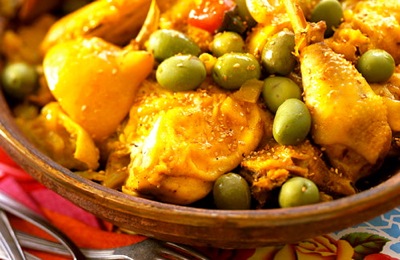
Chicken Olive and Preserved Lemon Tajine
Recipe: Chicken Tajine with Olives and Preserved Lemons
Rock salt
1 whole large chicken, cut into 8 pieces
1 tablespoon white wine vinegar
5 tablespoons olive oil
1 large bunch fresh cilantro, chopped
1 teaspoon cinnamon
1/2 teaspoon real saffron
Pinch fine salt
1/2 pound onions, chopped
5 cloves garlic, chopped
1 teaspoon cumin
1 teaspoon ground ginger
1 teaspoon paprika
1 teaspoon turmeric
1/4 pound gizzards, optional
1/4 pound chicken liver, optional
1/4 cup mixed olives, pitted
3 small preserved lemons
Making a Chicken Tajine with Olives and Preserved Lemons:
First rub the rock salt into the chicken pieces and then wash the chicken in the white wine vinegar and water. Leave for 10 minutes. Rinse and dry and place onto a clean plate. In a large bowl, mix the olive oil, coriander, cinnamon, saffron, fine salt, 1/2 the onions, garlic, cumin, ginger, paprika, turmeric. Mix all these ingredients into the oil and crush the garlic and add a little water to make a paste. Roll the chicken pieces into the marinade and leave for 10 to 15 minutes. For cooking, use an earthenware tajine (traditional Moroccan dish) or a deep, heavy bottom casserole dish. Heat the dish up and add 2 tablespoons of olive oil to the hot dish. Drop in the chicken and pour over the excess marinade juices. Add the remaining onions, gizzards, chicken livers, olives, and chopped preserved lemons (no pulp). Cook on a gas or electric stove for 45 minutes – 1 Hour. Allow the tajine to have a slight burn on the inside bottom. Serve with fresh bread
For more information about Moroccan Tajine recipes
For more information about Travel and Tours to Morocco plus highlights on Moroccan culture visit Morocco’s Imperial Cities, Seaside Resorts,Sahara Desert, Berber villages, A Taste of Morocco, Magical Kasbahs, Ruins & Waterfalls, Absolute Morocco, The Best of Marrakech, Fes, and Ouarzazate
Travel Exploration specializes in Morocco Travel. We provide Tours and travel opportunities to Morocco for the independent traveler and tailor-made tours for families and groups with a distinctly unique flavor. From Morocco’s Seven Imperial Cities, to the Magical Sahara Travel Exploration offers a captivating experience that will inspire you. At Travel Exploration we guarantee that you will discover the best of Morocco! Call Travel Exploration at 1 (800) 787-8806 or 1 (917)703-2078 and let’s book a tour to Morocco for you today.
Tajines in Morocco, Moroccan Tajine, Beef and prune tajine, Chicken and preserved lemon tajine, Tajine recipes, Moroccan tajine recipe, Moroccan preserved lemons, North African cuisine, North African cooking, Ras el hanout, Moroccan cuisine, Tajine, Sahara Desert, Tizin’ Tichka Pass, Ouarzazate, Clay Tajines, Cooking Moroccan Food, Moroccan recipes, Tajine recipes, Moroccan tajine recipe, Beef and Prune Tajine recipes, Chicken and Preserved Lemon Tajine recipe, Morocco private tours, Morocco Holidays, Morocco Travel, Travel Exploration, Travel to Morocco


